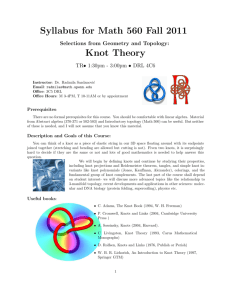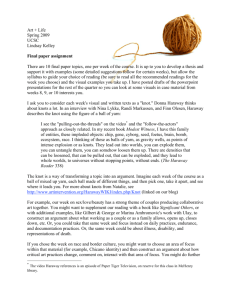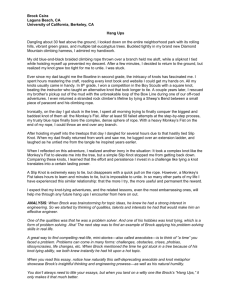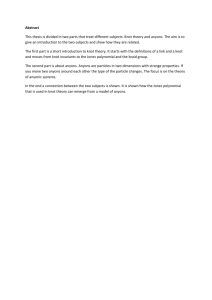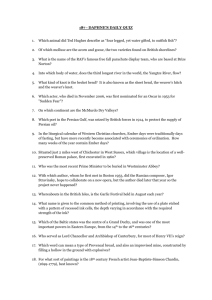Seifert’s algorithm Invariants
advertisement
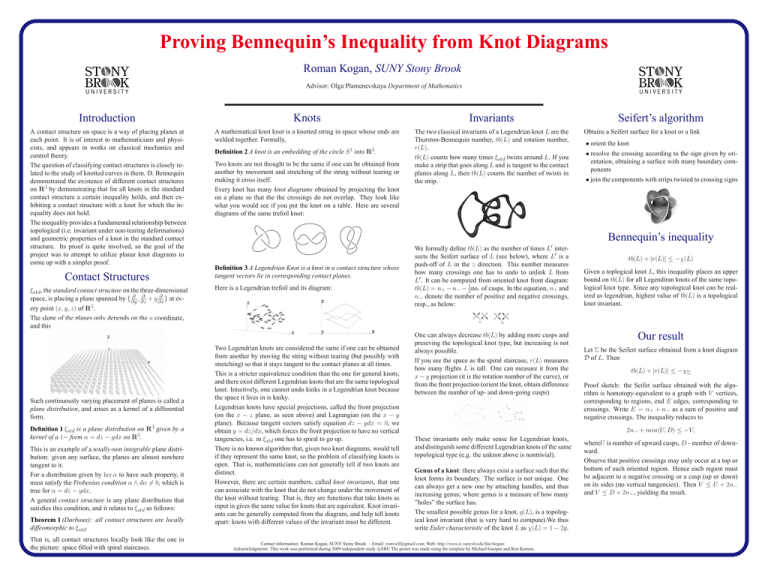
Proving Bennequin’s Inequality from Knot Diagrams
Roman Kogan, SUNY Stony Brook
Advisor: Olga Plamenevskaya Department of Mathematics
Introduction
Knots
Invariants
A contact structure on space is a way of placing planes at
each point. It is of interest to mathematicians and physicists, and appears in works on classical mechanics and
control theory.
The question of classifying contact structures is closely related to the study of knotted curves in them. D. Bennequin
demonstrated the existence of different contact structures
on R3 by demonstrating that for all knots in the standard
contact structure a certain inequality holds, and then exhibiting a contact structure with a knot for which the inequality does not hold.
The inequality provides a fundamental relationship between
topological (i.e. invariant under non-tearing deformations)
and geometric properties of a knot in the standard contact
structure. Its proof is quite involved, so the goal of the
project was to attempt to utilize planar knot diagrams to
come up with a simpler proof.
A mathematical knot knot is a knotted string in space whose ends are
welded together. Formally,
The two classical invariants of a Legendrian knot L are the
Thurston-Bennequin number, tb(L) and rotation number,
r(L).
tb(L) counts how many times ξstd twists around L. If you
make a strip that goes along L and is tangent to the contact
planes along L, then tb(L) counts the number of twists in
the strip.
Contact Structures
ξstd, the standard contact structure on the three-dimensional
∂ , ∂ + y ∂ } at evspace, is placing a plane spanned by { ∂y
∂z
∂x
ery point (x, y, z) of R3.
The slope of the planes only depends on the y coordinate,
and this is how the planes look at z = 0:
Such continuously varying placement of planes is called a
plane distribution, and arises as a kernel of a differential
form.
Definition 1 ξstd is a plane distribution on R3 given by a
kernel of a 1− form α = dz − ydx on R3.
This is an example of a totally-non integrable plane distribution: given any surface, the planes are almost nowhere
tangent to it.
For a distribution given by ker α to have such property, it
must satisfy the Frobenius condition α ∧ dα 6= 0, which is
true for α = dz − ydx.
A general contact structure is any plane distribution that
satisfies this condition, and it relates to ξstd as follows:
Theorem 1 (Darboux): all contact structures are locally
diffeomorphic to ξstd.
That is, all contact structures locally look like the one in
the picture: space filled with spiral staircases.
Definition 2 A knot is an embedding of the circle S 1 into R3.
Two knots are not thought to be the same if one can be obtained from
another by movement and stretching of the string without tearing or
making it cross itself.
Every knot has many knot diagrams obtained by projecting the knot
on a plane so that the the crossings do not overlap. They look like
what you would see if you put the knot on a table. Here are several
diagrams of the same trefoil knot:
Seifert’s algorithm
Obtains a Seifert surface for a knot or a link
• orient the knot
• resolve the crossing according to the sign given by orientation, obtaining a surface with many boundary components
• join the components with strips twisted to crossing signs
Bennequin’s inequality
Definition 3 A Legendrian Knot is a knot in a contact structure whose
tangent vectors lie in corresponding contact planes.
Here is a Legendrian trefoil and its diagram:
Two Legendrian knots are considered the same if one can be obtained
from another by moving the string without tearing (but possibly with
stretching) so that it stays tangent to the contact planes at all times.
This is a stricter equivalence condition than the one for general knots,
and there exist different Legendrian knots that are the same topological
knot. Intuitively, one cannot undo kinks in a Legendrian knot because
the space it lives in is kniky.
Legendrian knots have special projections, called the front projection
(on the x − z plane, as seen above) and Lagrangian (on the x − y
plane). Because tangent vectors satisfy equation dz − ydx = 0, we
obtain y = dz/dx, which forces the front projection to have no vertical
tangencies, i.e. in ξstd one has to spiral to go up.
There is no known algorithm that, given two knot diagrams, would tell
if they represent the same knot, so the problem of classifying knots is
open. That is, mathematicians can not generally tell if two knots are
distinct.
However, there are certain numbers, called knot invariants, that one
can associate with the knot that do not change under the movement of
the knot without tearing. That is, they are functions that take knots as
input in gives the same value for knots that are equivalent. Knot invariants can be generally computed from the diagram, and help tell knots
apart: knots with different values of the invariant must be different.
We formally define tb(L) as the number of times L′ intersects the Seifert surface of L (see below), where L′ is a
push-off of L in the z direction. This number measures
how many crossings one has to undo to unlink L from
L′. It can be computed from oriented knot front diagram:
tb(L) = n+ − n− − 12 no. of cusps. In the equation, n+ and
n− denote the number of positive and negative crossings,
resp., as below:
One can always decrease tb(L) by adding more cusps and
preseving the topological knot type, but increasing is not
always possible.
If you see the space as the spiral staircase, r(L) measures
how many flights L is tall. One can measure it from the
x − y projection (it is the rotation number of the curve), or
from the front projection (orient the knot, obtain difference
between the number of up- and down-going cusps).
tb(L) + |r(L)| ≤ −χ(L)
Given a toplogical knot L, this inequality places an upper
bound on tb(L) for all Legendiran knots of the same topological knot type. Since any topological knot can be realized as legendrian, highest value of tb(L) is a topological
knot invariant.
Our result
Let Σ be the Seifert surface obtained from a knot diagram
D of L. Then
tb(L) + |r(L)| ≤ −χΣ
Proof sketch: the Seifet surface obtained with the algorithm is homotopy-equivalent to a graph with V vertices,
corresponding to regions, end E edges, corresponding to
crossings. Write E = n+ + n− as a sum of positive and
negative crossings. The inequality reduces to
2n− + min(U, D) ≤ −V,
These invariants only make sense for Legendrian knots,
and distinguish some different Legendrian knots of the same
topological type (e.g. the unknot above is nontrivial).
Genus of a knot: there always exist a surface such that the
knot forms its boundary. The surface is not unique. One
can always get a new one by attaching handles, and thus
increasing genus; where genus is a measure of how many
”holes” the surface has.
The smallest possible genus for a knot, g(L), is a topological knot invariant (that is very hard to compute).We thus
write Euler characteristic of the knot L as χ(L) = 1 − 2g.
Contact information: Roman Kogan, SUNY Stony Brook – Email: romwell@gmail.com; Web: http://www.ic.sunysb.edu/Stu/rkogan
Acknowledgments: This work was performed during 2009 independent study @SBU The poster was made using the template by Michael Gastpar and Ron Kumon.
whereU is number of upward cusps, D - number of downward.
Observe that positive crossings may only occur at a top or
bottom of each oriented region. Hence each region must
be adjacent to a negative crossing or a cusp (up or down)
on its sides (no vertical tangencies). Then V ≤ U + 2n−
and V ≤ D + 2n−, yielding the result.


